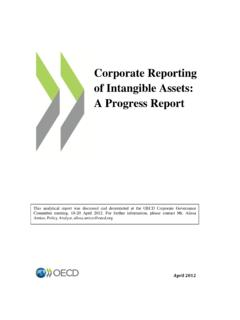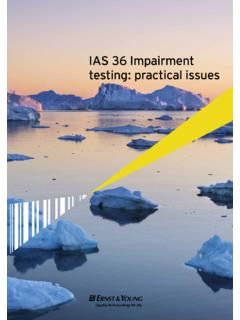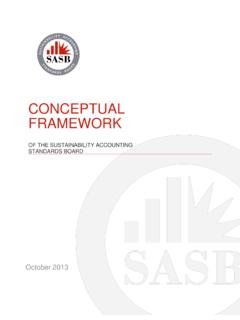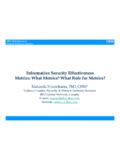Transcription of Integrated reporting - EY - United States
1 Integrated reporting | Linking strategy, purpose and value | 1 Integrated reportingLinking strategy, purpose and value 2 | Integrated reporting | Linking strategy, purpose and value PerspectiveContents3 Perspective from Juan Costa Climent, Global Leader EY Climate Change and Sustainability Services4 Keeping up with the Integrated reporting pacesetters6 Old words, new meanings7 Expanded requirements and more voluntary integration8 A growing practice10 EY clients seeking better not more informationIntegrated reporting | Linking strategy, purpose and value | 3 For a growing number of business stakeholders, traditional reporting models are being challenged to keep pace with a 21st century redefinition of value and a growing desire to see beyond conventional financial data.
2 A broader understanding of value is taking hold. It goes beyond financial capital to recognize two further territories: first, the shared value an organization creates which benefits its direct stakeholders; and second, the value it generates for society and the environment. Using all three of these value territories to guide reporting holds huge potential for companies, enabling a fuller understanding of their risks and, crucially, of opportunities am excited by the ability of this new approach to build richer pictures of companies unique value creation stories. It builds a more holistic foundation on which to base improved decision-making by both companies and investors.
3 This is precisely why investors are asking for nonfinancial information: they understand its potential to close the gap between intrinsic and market value. But adding nonfinancial disclosures as an afterthought to financial disclosures isn t the answer: investors want better, not more, data. Companies looking to respond are working to, first, widen the value territories explored and, then, narrow their focus by prioritizing those issues that are material in each individual case. This focus is what excites us most; we know each client is going to demand a tailored approach and the progressive companies understand that it takes more than relying on standard formulae.
4 This creates streamlined and relevant reporting , answering real investor needs rather than taking the tick-box approach that has typically guided sustainability reporting in the past. We are privileged to work with many of the market leaders in this new space, helping them to tell their stories on their own terms and building market confidence in the process. Such stories draw together the multiple ways in which organizations create value to tell one complete narrative, recognizing the interdependency between its component parts. Given the increasing uptake of this Integrated approach, I anticipate a different looking reporting landscape 10 years from now and forward-thinking companies can position themselves to be ahead of the curve.
5 Will Integrated reporting be mandatory? How will intangibles be represented on the balance sheet? And what will investors look for when they seek to understand a company s value? According to key members of the International Integrated reporting Council (IIRC), between 1,200 and 1,500 companies were expected to publish Integrated reports last year, which makes anticipating such questions vital for companies wishing to flourish in the 21st century. from Juan Costa ClimentJuan Costa Climent Global Leader, EY Climate Change and Sustainability ServicesPerspective4 | Integrated reporting | Linking strategy, purpose and value said that nonfinancial performance information played a crucial role at least once a month in their decision-making.
6 And so the market is influenced by the information that companies and other organizations provide: the quality, content and consistency of disclosures are therefore important to functional and flourishing capital markets. But a series of shocks has contributed to a series of apparent moves toward new, more Integrated disclosure techniques. The 2008 financial crisis was a watershed moment. While progressive companies were demonstrating an understanding of how sustainability issues affected their overall operations, many companies adopted a tick-box approach to reporting on those issues. Some chose to publish the traditionally necessary information, overlooking information that might have been most useful for investors and broader society.
7 When the crisis hit, capital markets decision-makers realized that while information was abundant, there was a lack of good and reliable nonfinancial information that may have helped to add detail and context. That experience is one of multiple pressures that is propelling reporting into a new phase: our growing understanding of environmental limits and new expectations of responsible business are crucial, as it flips externalities to internalities. Resource use, emissions and reliance on all forms of human, natural, social and intellectual capital can no longer be considered as separate to company operations, relegated to a corporate responsibility department.
8 Instead, they bring revolutionary implications for the balance sheet over the medium and long term, if not now. And these implications aren t always negative: companies often stand to benefit when they openly identify activities external to an organization and directly link them to the creation of intangible asset value for the organization. Understanding externalities is vital in an age of global connectivity and its accompanying scrutiny: anyone can now tweet a photo from a company supply chain or access reporting information online. There are few dark corners left in which corporate practices can hide, meaning that companies need to tell their story on their own terms if transparency is to work in their favor rather than against up with Integrated reporting pacesettersEY s day-to-day proximity to leading-edge Integrated reporting practices provides a growing portfolio of indicators that innovation in corporate reporting is beginning to take hold.
9 Successful companies are finding new ways to make corporate reporting fit-for-purpose in the 21st century. And purpose is key here. Often obscured by bureaucracy and increasing numbers of guidelines, reporting is really very simple: it exists so that everyone with an interest in an organization s behavior and performance can understand its purpose, impacts and future prospects. Financial data enables this, and nonfinancial data does as well. Nonfinancial data often becomes financially relevant over time and discussions around nonfinancial data should include sustainability, ESG, EH&S and CSR measures. Investors use this information as a decision-making tool; in fact, three-quarters of investors surveyed in our 2015 report, Tomorrow s investment rules , While progressive companies were demonstrating an understanding of how sustainability issues affected their overall operations, many companies adopted a tick-box approach to reporting on those reporting | Linking strategy, purpose and value | 56 | Integrated reporting | Linking strategy, purpose and value understanding of the resources and events that affect business, enabling better risk management in the process.
10 They provide nonfinancial data with its own, more appropriate litmus test for prioritization of what is important. Companies no longer view nonfinancial data as simply nice to have and added on as an afterthought; they now understand that nonfinancial data is an essential management tool, one that provides a fuller and more detailed picture of a company s role in the world. Most often, it is talked about in the context of demonstrating and managing risks, but when collected and used properly, it also highlights commercial opportunities that may otherwise be obscured. The success stories of tomorrow, therefore, recognize that nonfinancial disclosures are integral to business today and have an indirect financial impact over time.

















